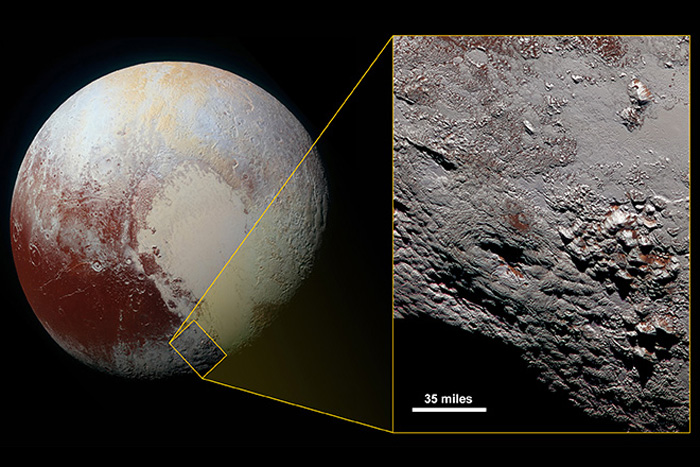A 'Wright Mons-ter': Pluto's Ice Volcano Is Huge

Pluto’s weirdly dynamic and “young” surface has just become even more intriguing with the release of this stunning color image of what is thought to be a huge cryovolcano, or ice volcano.
ANALYSIS: ‘X’ Marks the Convective Spot on ‘Lava Lamp’ Pluto
As the dwarf planet is so far away from the sun, it was assumed, before the historic New Horizons Pluto flyby in July, that it would be a frozen, static and crater-filled world. But as observations by the NASA spacecraft are showing us, Pluto has an astonishing impact crater-less surface, with some regions dominated by dynamical atmospheric and surface processes.
Pluto may be cold, but even ices in the Kuiper Belt are slowly moving, even setting up their own “lava lamp”-like convection flows. It is also hypothesized that through the heating of ices inside Pluto’s crust, melted volatiles (like water or methane) will erupt to the surface, much like molten rock erupts from the core of our planet to form volcanoes.
ANALYSIS: New Horizons Returns Photos of Hazy ‘Arctic’ Pluto
Now, with the discovery of this 2.5 mile-high mountain on Pluto’s surface, planetary scientists are trying to understand how the 90 miles-wide feature formed and whether it could be yet another sign of the small world’s surprising dynamism and a striking example of cryovolcanism.
Informally named “Wright Mons,” should this huge feature indeed be confirmed to be a cryovolcano it will be the largest such example in the outer solar system. (The inner solar system, of course, is dominated by the Martian mega-volcano Olympus Mons that pushes above the Red Planet’s atmosphere, towering 16 miles high.)
Get the Space.com Newsletter
Breaking space news, the latest updates on rocket launches, skywatching events and more!
Of particular interest in this color image of Wright Mons is the distribution of red material — why isn’t it more widespread around Pluto’s globe? Also, there appears to be few impact craters around Wright Mons, in fact, there is only one impact crater on the mountain itself. This tells us that if it really is an ice volcano, it had to have been active in recent geological history — if it was an inactive, static artifact, it should be peppered with impact craters. Instead, it appears recently active processes — possibly related to Pluto’s ice — have eroded most of the impact craters away.
NEWS: Weird Pluto Mountains Are Evidence of Ice Volcanoes
In short, Pluto is telling us a story through its surprisingly active geologic processes, processes that few scientists would have bet on existing in the outermost reaches of the solar system before New Horizons' dwarf planet encounter.
Source: NASA
Originally published on Discover News.
Join our Space Forums to keep talking space on the latest missions, night sky and more! And if you have a news tip, correction or comment, let us know at: community@space.com.
Ian O'Neill is a media relations specialist at NASA's Jet Propulsion Laboratory (JPL) in Southern California. Prior to joining JPL, he served as editor for the Astronomical Society of the Pacific‘s Mercury magazine and Mercury Online and contributed articles to a number of other publications, including Space.com, Space.com, Live Science, HISTORY.com, Scientific American. Ian holds a Ph.D in solar physics and a master's degree in planetary and space physics.









